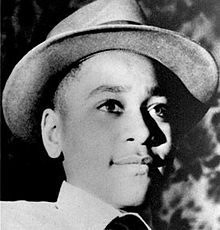Murder, kidnapping of 14-year-old Emmett Till

When a 14-year-old is killed, it usually does not make national news. However, in 1955, the kidnapping and murder of 14-year-old Emmett Louis Till in Money, Mississippi, continues to make headlines.
lam and Bryant were tried and acquitted by an all-white, all-male jury. The jury deliberated for a little over an hour and returned the innocent verdict despite overwhelming evidence that the defendants were guilty.
and were never brought to justice.
Till’s body was exhumed by the FBI in 2005 and an autopsy performed and identified as belonging to Till. By 2007, a grand jury decided not to seek an in-
drove to Glendora, Mississippi to a shed located behind Milam’s home and pistol-whipped him.
Till, whose nickname was Bobo, lived in Chicago, Illinois. He traveled to Mississippi to visit relatives and stay at the home of his great-uncle Mosses Wright.
Four months after their trial, the two- white men from Mississippi, recounted in the January 1956’s “Look” magazine how they beat Till with a gun, shot him and threw his body in the Tallahatchie River with a 75-pound cotton-gin fan attached with barbed wire to his neck to weigh the body down. They were allegedly paid $1,500 each for the interview and could not be tried again because of the Double-Jeopardy Clause.
indictment against additional individuals.
After deciding to kill Till, they traveled to a cotton gin at Boyle, Mississippi, and picked up a discarded gin fan. Milam is quoted as saying, “When we got to that gin, it was daylight and I was worried for the first time. Somebody might see us and accuse us of stealing the fan.”
On Aug. 24, he went into Bryant’s Grocery and Meat Market to buy candy. At some point, he allegedly whistled at Carolyn Bryant, a white woman who ran the store with her husband Roy who was away at the time. She claimed Till grabbed her, made lewd advances and wolf-whistled at her as he sauntered out.
Till’s mother ordered the top of her son’s conflicted, so people could see his horribly damaged face. “Let the people see what they did to my boy!” she said. Crowds estimated in size from 10,000 to 50,000 descend on the Chicago funeral home.
Once they arrived at the Tallahatchie River, they shot Till and threw his body in, according to the “Look” magazine interview.
His harmless action carried weight in an era of segregation and Jim Crow laws that ruled the South. Four days later, Till, who was black, was abducted from his great-uncle’s house by J.W. Milam and Roy Bryant.
NY Times, Jan. 27, 2017
The facts of his murder are murky and unsubstantiated. Three days after his death, his corpse was recovered, but so disgured that his great-uncle could not identify him except for an initialed ring.
In 1963, Bob Dylan records a song called “The Death of Emmett Till.”
FBI notes:
Four six decades, Carolyn Bryant who was linked to one of the most notorious crimes in the nation’s history, the lynching of Till, broke her silence and talked to Tim Tyson, a Duke University professor. In his book, “The Blood of Emmett Till,” she is quoted as saying that Till did not grab her and was not menacing and sexually crude toward her…Nothing that boy did could ever justify what happened to him.”
Within a month after the murder, Mi-
Hundreds of thousands of people, mostly in northern cities, attended rallies protesting the verdict in the Till-murder trial. In Mississippi, membership in segregation-supporting White Citizen’s Councils skyrocketed.
The burial was postponed to allow additional time for the public to view Till’s body. Meanwhile, largely in response to the national attention the case attracted, people in Mississippi decide to use the trial to send a message to outsiders. All five lawyers of the town of Sumner, Mississippi, agree to defend Bryant and Milam. The sheriff is not convinced that the body pulled from the Tallahatchie River was really that of Till.
The FBI’s evidence reveals a number of inconsistencies and differences in its nine-page report.
The U.S. Justice Department reopened the case in 2004, amid suggestions that other people – some of whom were still alive – might have participated in the crime. Milam and Bryant both had died
After picking up Till at 2 a.m., Milam and Bryant attempted to find a bluff along the Mississippi River at which to whip Till and scare him, but could not find it, after driving almost 75 miles. By 5 a.m., they drove to Glendora, Mississippi to a shed located behind Milam’s home and pistol-whipped him. After deciding to kill Till, they traveled to a cotton gin at Boyle, Mississippi, and picked up a discarded gin fan. Milam is quoted as saying, “When we got to that gin, it was daylight and I was worried for the first time. Somebody might see us and accuse us of stealing the fan.” Once they arrived at the Tallahatchie River, they shot Till and threw his body in, according to the “Look” magazine interview. The FBI’s evidence reveals a number of inconsistencies and differences in its nine-page report. NY Times, Jan. 27, 2017 Four six decades, Carolyn Bryant who was linked to one of the most notorious crimes in the nation’s history, the lynching of Till, broke her silence and talked to Tim Tyson, a Duke University professor. In his book, “The Blood of Emmett Till,” she is quoted as saying that Till did not grab her and was not menacing and sexually crude toward her…Nothing that boy did could ever justify what happened to him.”




